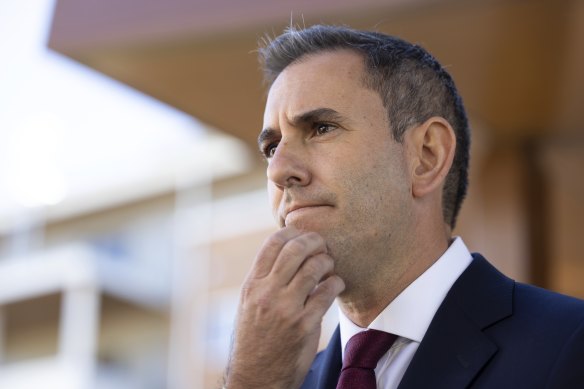The federal government has delayed the point at which its total debt exceeds $1 trillion as it comes within sight of balancing the budget this year on the strength of unexpectedly high commodity prices and record numbers of people in work.
Despite the rapid improvement in the budget bottom line, taxpayers will spend more than $110 billion over the next five years paying the interest bill on government debt, a bill larger than family tax benefits or childcare subsidies.

The budget will show the nation’s interest bill on track to reach $112 billion over the next five years - but total debt and smaller deficits mean the interest bill is slowing.Credit: Alex Ellinghausen
But even that interest bill is a substantial improvement on where Treasurer Jim Chalmers feared the budget would be less than seven months ago.
Interest on government debt is the single fastest-growing budget expense, as record-sized deficits due to spending through the pandemic lockdowns were exacerbated by a surge in global interest rates.
Chalmers will reveal in the budget that total interest payments on debt will reach $111.8 billion between 2022-23 and 2026-27. The interest repayments equate to $60 million a day or $2.5 million an hour.
In 2023-24 alone, interest repayments will reach $19.8 billion, an increase of $2.2 billion over the current financial year. The interest bill will be larger than what the government expects to spend on infrastructure.
Chalmers said interest payments were a growing problem but signalled the budget was also improving.
“The cost of servicing the debt left behind by our predecessors is one of the fastest growing pressures on Tuesday’s budget,” he said.
“We’ve made substantial progress when it comes to repairing the budget and we’ll continue our efforts in the budget I hand down on Tuesday.”
But the size of the nation’s interest bill is growing slower than the government had feared.
In the October budget, the government was expecting to spend almost $96 billion in interest on its outstanding debt between 2022-23 and 2025-26. Tuesday’s budget is expected to show the interest bill for that period at almost $86 billion.
A combination of high commodity prices, the strong jobs market, a lift in wages and high inflation all mean budget deficits are expected to be smaller.
In October, Chalmers forecast the budget deficit this financial year to be $36.9 billion and then $44 billion in 2023-24.
He is now expected to show a much smaller deficit or even be in balance due to a surge in tax revenues from the mining and banking sectors plus personal tax collections from the record 13.9 million Australians with a job.
Deloitte Access Economics estimates tax revenues alone are $37.6 billion stronger this financial year compared to what was forecast in the October budget. It estimates total revenues are $41.3 billion stronger.
That extra revenue will reduce total gross government debt that was first forecast to exceed $1 trillion in the 2020-21 budget delivered by then-treasurer Josh Frydenberg during the depths of the COVID pandemic. He forecast debt to reach $1.02 trillion in 2021-22 and hit $1.14 trillion by 2023-24.
In Frydenberg’s last budget, in March last year, he forecast debt to reach $1.06 trillion in 2023-24. This was revised down in Chalmers’ October budget to just over $1 trillion.
Chalmers next week will push back by at least one year when the $1 trillion mark will be reached.
Data from the Australian Bureau of Statistics on Thursday highlighted the revenue benefits flowing to the budget, which is keeping a lid on total government debt.
Through March, the nation recorded a $15.3 billion trade surplus, the second-highest on record.
It was driven by an 11.6 per cent or $1.6 billion jump in iron ore exports. Exports of rural goods increased by almost 11 per cent or $700 million through the month.
Jameson Coombs and Pat Bustamante of St George Economics on Thursday said falling interest rates would reduce government payments by $40 billion over the next decade.
They said high commodity prices, the strength of the domestic economy and the lift in net overseas migration all meant government debt would be lower.
“The windfall will reduce the expected budget deficit and the amount the government needs to borrow, or the government’s ongoing financing task,” they said.
Cut through the noise of federal politics with news, views and expert analysis from Jacqueline Maley. Subscribers can sign up to our weekly Inside Politics newsletter here.
Most Viewed in Politics
https://news.google.com/rss/articles/CBMihwFodHRwczovL3d3dy5zbWguY29tLmF1L3BvbGl0aWNzL2ZlZGVyYWwvdHJpbGxpb24tZG9sbGFyLWRlYnQtZGVsYXllZC1idXQtaW50ZXJlc3QtYmlsbC1hY2NlbGVyYXRlcy10by0yLTVtLWFuLWhvdXItMjAyMzA1MDQtcDVkNWtqLmh0bWzSAYcBaHR0cHM6Ly9hbXAuc21oLmNvbS5hdS9wb2xpdGljcy9mZWRlcmFsL3RyaWxsaW9uLWRvbGxhci1kZWJ0LWRlbGF5ZWQtYnV0LWludGVyZXN0LWJpbGwtYWNjZWxlcmF0ZXMtdG8tMi01bS1hbi1ob3VyLTIwMjMwNTA0LXA1ZDVrai5odG1s?oc=5
2023-05-04 12:30:00Z
2005587941
Bagikan Berita Ini














0 Response to "Trillion-dollar debt delayed but interest bill accelerates to $2.5m an hour - Sydney Morning Herald"
Post a Comment